Antioxidative effects of encapsulated sodium tripolyphosphate and encapsulated sodium acid pyrophosphate in ground beef patties cooked immediately after antioxidant incorporation and stored
Abstract
Ground beef with 1% NaCl was incorporated with 0.5% unencapsulated sodium tripolyphosphate (uSTP), 0.5% encapsulated sodium tripolyphosphate (eSTP), 0.5% unencapsulated sodium acid pyrophosphate (uSAPP), or 0.5% encapsulated sodium acid pyrophosphate (eSAPP) prior to being cooked and stored (0 or 6?d, 3?°C). The pH was higher (P?<?0.05) for sodium tripolyphosphate samples (6?d: uSTP 5.98; eSTP 5.89) and lower (P?<?0.05) for sodium acid pyrophosphate (6?d: uSAPP 5.31, eSAPP 5.33) samples than control sample (6?d, 5.50). Overall, samples with uSTP had the least cooking loss and lowest TBARS values. TBARS (mg/kg) for the phosphate treatments were lower (P?<?0.05; ave. 1.78, 0?d; 3.49, 6?d) than for the control samples (3.07, 0?d; 22.85, 6?d). Therefore, phosphate incorporation into ground beef prior to cooking aids in the reduction of oxidation in the cooked, stored product, although a longer period of time before thermal processing may be necessary for the encapsulated phosphate to have significant benefits.





